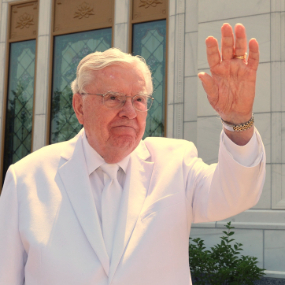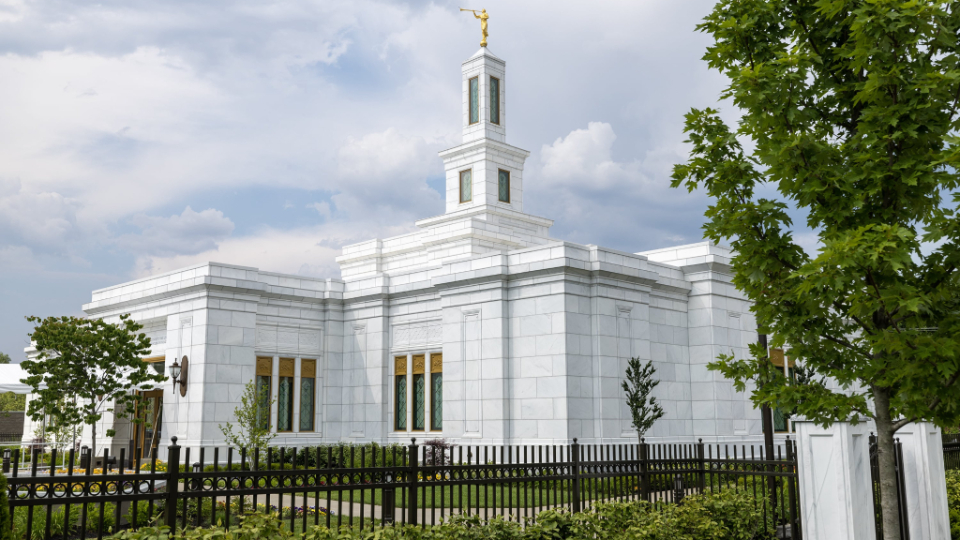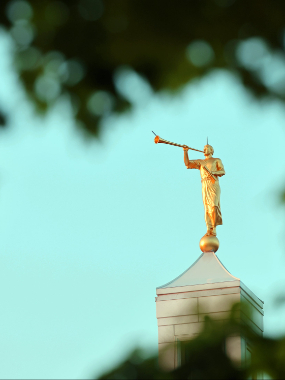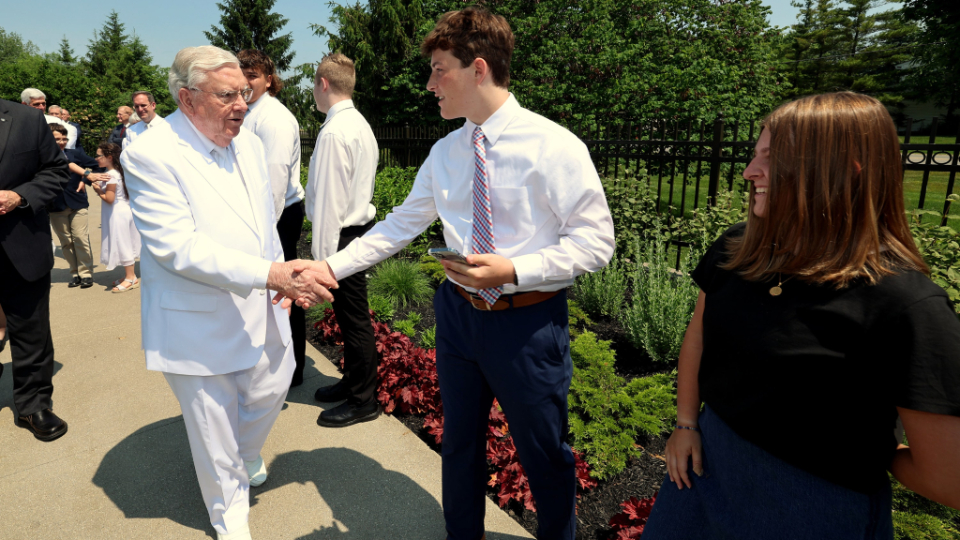In January 1831, the Lord instructed early members of The Church of Jesus Christ of Latter-day Saints to “go to the Ohio” where they would be given God’s law and “endowed with power from on high” (Doctrine and Covenants 38:32).
The following month, the Prophet Joseph Smith and his pregnant wife, Emma Smith, moved to Kirtland, Ohio. They worked to establish their home and the Church, and, in March 1836, Joseph dedicated a temple. The Heavens rejoiced and the Saints received an outpouring of spiritual gifts and manifestations.
Fleeing persecution in 1838, they left their beloved temple behind.
- Columbus-Temple-rededication
- Columbus-Temple-rededication
- Columbus-Temple-rededication
- Columbus-Temple-rededication
- Columbus-Temple-rededication
- Columbus-Temple-rededication
- Columbus-Temple-rededication
- Columbus-Temple-rededication
- Columbus-Temple-rededication
- Columbus-Temple-rededication
| Temple Square is always beautiful in the springtime. Gardeners work to prepare the ground for General Conference. © 2012 Intellectual Reserve, Inc. All rights reserved. | 1 / 2 |
Now 187 years later, members of The Church of Jesus Christ of Latter-day Saints in Ohio are once again “endowed with power from on high” in their home state.
On Sunday, June 4, President M. Russell Ballard, Acting President of the Quorum of the Twelve Apostles, rededicated the Columbus Ohio Temple, located 160 miles southwest of Kirtland.
Closed for three years to undergo extensive renovation, the 11,745 square-foot temple sits on five acres in central Ohio.
Every temple displays the words, “Holiness to the Lord. The House of the Lord,” President Ballard said. “I testify that the temples are the houses of the Lord. It is here where Heavenly Father instructs His children and helps us prepare to return to His presence. It is here where we receive personal revelation, make covenants with Heavenly Father, the Savior, and participate in eternal ordinances.”
Joining President Ballard in rededicating the temple were Elder Kevin R. Duncan, General Authority Seventy and executive director of the Temple Department, and his wife, Sister Nancy S. Duncan; Elder Allen D. Haynie, a General Authority Seventy and North America Northeast Area president, and his wife, Sister Deborah H. Haynie; and Elder Gary B. Sabin, General Authority Seventy and second counselor in the North America West Area presidency, and his wife, Sister Valerie P. Sabin. The two sessions were broadcast throughout the temple district, which includes stakes across Ohio to Pittsburgh, Pennsylvania, and Charleston, West Virginia.
There are more than 63,000 members of the Church in Ohio, in 15 stakes and 125 congregations.
Kirtland Temple
Reflecting on the history of the Church in the state, President Ballard noted that in December of 1830, the Lord identified “the Ohio” as the gathering place for His Church. Further revelations asked the Saints to establish “a house of God” in Kirtland, Ohio.
In response to this call, building the temple became the immediate priority for early Church members, and they began construction in June 1833.
President Ballard noted that Hyrum Smith, the brother of the Prophet Joseph and his great-great-grandfather, was the first to begin digging a trench on the temple site, declaring that “he would strike the first blow upon the house.”
Early Latter-day Saints built the temple with urgency — sacrificing not only physical labor, but also donating land, clothing, and cash to the project, explained President Ballard.
“The unceasing desire was to receive their promised blessings to be ‘endowed with power from on high,’” said President Ballard, quoting Doctrine and Covenants 38:3.
Heavenly Father and Jesus Christ appeared in the Kirtland Temple, as did Moses, Elijah and Elias, he said. It was also in Kirtland, Ohio, where 65 of the 138 sections of the Doctrine and Covenants were received.
“In a lot of ways, the heavens were open and the word of the Lord flowed through the Prophet Joseph Smith,” President Ballard said.

Columbus-Temple-rededication
President M. Russell Ballard, Acting President of the Quorum of the Twelve Apostles, waves to someone off camera on the grounds of the Columbus Ohio Temple in Columbus, Ohio, on June 4, 2023.Church members today also have access to this endowment of power.
President Ballard said he hopes Latter-day Saints will “see the temple as a place of refuge, a place of peace, a place where people can commune spiritually just by being in a dedicated house of the Lord. …
“Heaven is as close as it can be in the temple because it is the house of the Lord.”
Columbus Ohio Temple
President Gordon B. Hinckley announced the Columbus Ohio Temple during a visit on April 25, 1998; he later dedicated the completed edifice on Sept. 4, 1999, as the Church’s 60th temple.
“Much has changed in the 163 years since the Kirtland Temple was dedicated,” said President Hinckley during the 1999 temple dedication. “Our people are more accepted now. It is a new day of opportunity. The struggles of Kirtland are past.”
Still, honoring the historical significance of the area, President Hinckley and President Ballard quoted the Kirtland Temple dedicatory prayer Joseph Smith gave in the dedication and rededication prayers offered at the temple.
Referencing Doctrine and Covenants 109:16, 21-23, President Ballard prayed that Latter-day Saints “may go forth from this house armed with thy power and that thy name may be upon them, and thy glory be round about them, and thine angels have charge over them.
“And from this place they may bear exceedingly great and glorious tidings, in truth, unto the ends of the earth, that they may know that this is thy work and that thou hast put forth thy hand, to fulfill that which thou hast spoken by the mouths of the prophets.”
This will be possible as never before in Ohio, as the First Presidency has announced more temples for the area.
In April 2022 general conference, President Russell M. Nelson announced a temple for Cleveland, Ohio; the Church released the Cleveland temple’s location last December.
Also in the temple district, a temple in Pittsburgh is under construction with a groundbreaking on Aug. 21, 2021. It was announced by President Nelson in the April 2020 general conference.
Ralph Henricks and other members remember how President Hinckley’s April 25, 1998, address felt much like a “temple recommend interview.”
At the conclusion of his address, he declared that “the time has come to build a temple in this great state of Ohio.”

Columbus-Temple-rededication
The Columbus Ohio Temple in Columbus, Ohio, on June 3, 2023.Henricks, who lives 3.1 miles from the temple, took almost daily pictures of the construction of the building — which was dedicated by President Hinckley on Sept. 4, 1999, on Henricks’ wedding anniversary.
Henricks met his wife, Mary Kay Laugherty, in central Ohio in 1962 as a young airman. She had grown up in Columbus and worshipped with her family in the first Latter-day Saint meeting house built in the city. The meeting house, dedicated in 1930, was located just north of Ohio State University.
In 1979, the couple settled in Columbus themselves; he served as a stake clerk and historian for almost two decades.
He will never forget participating in the dedication of the Church’s Gateway chapel in Ohio and hearing a dedicatory prayer offered by President Keith Smith (who is now the current temple president in Columbus). In the prayer, President Smith promised members of the stake that if they were worthy, they may have a temple “even at the doorstep.”
“I was surprised,” said Henricks. “This was several years before the temple was considered.”
Later, when President Hinckley announced the temple for Columbus, a couple of locations were considered. Still, the temple was built on the doorstep of the Gateway chapel.
The 2023 rededication was the first temple dedication for siblings Russel Boss, 12, and Elizabeth “Eliza” Boss, 10, of the Gahanna 1st Ward, Columbus Ohio South Stake, who also got to shake hands with President Ballard. As their parents, Dave and Chelsea Boss, prepared their family, including two more younger children, they discussed how the temple would be different.
Russel agreed with his dad that there was a different feeling in the temple after the dedication.
Their mother Chelsea Boss said, “It was a sacred, special experience. It felt like heaven.”
Temple Open House
The First Presidency announced on March 27, 2020 — two days after closing all temple operations due to the onset of the COVID-19 pandemic — that the Columbus temple would close for renovations on Aug. 15, 2020.
During the renovation, building acoustics were improved, windows were created or enlarged to provide greater access to natural light and additional art glass was installed.

Columbus-Temple-rededication
An Angel Moroni statue on top of the spire of the Columbus Ohio Temple in Columbus, Ohio, on June 4, 2023.Astrid Kron, who has lived in the Columbus area for more than 30 years, said even before the temple was dedicated, it felt like “the house of the Lord.”
Organizers estimated that, after the renovation, more than 20,000 people toured the temple during the open house, including Ohio Gov. Mike DeWine.
Marc and Debbie Halley had lived in Dublin, Ohio, for more than 25 years and raised their six children there when they were invited to serve as associate coordinators for the temple open house and dedication committee. They accepted the assignment, even though they were preparing to move to Arizona in a few weeks. They worked with many others to organize the open house via video conferencing and periodic trips to the area.
During the open house, Debbie Halley would check in with the volunteers and give them their assignments. “As they came back, it was just the neatest thing to see their countenances change after they had been in the temple,” she said.
Some volunteers would drive three to three and a half hours to volunteer for a four-hour shift during the open house. Missionaries, including sisters and senior couples, were from the Columbus Ohio Mission.
Both served as temple workers prior to the temple closing. “This has been a special place for us for many years,” Marc Halley said.
They also hosted different groups visiting the temple, including the contractors who had worked on the temple and those in a nearby neighborhood who had seen the work on the temple for the past three years.
“They felt the beauty. It wasn’t just a box. They felt something when they were here,” Marc Halley said of the reactions they noticed in many people who came to the temple.
A Temple in Central Ohio
Columbus — the 14th largest city in the United States and the fastest growing city in the Midwest — is known for Buckeyes football at Ohio State University — the third largest university in the United States. “Central Ohio is a great place to raise a family. It’s inexpensive to live here, family values still matter, and the community is fun and vibrant,” said Stephen Kron of the Columbus Ohio North Stake. He served on the parking and transportation subcommittee for the open house.

Columbus-Temple-rededication
Local Latter-day Saints gather for the rededication of the Columbus Ohio Temple in Columbus, Ohio, on June 4, 2023.Molly Mortensen moved to Columbus in 1957 when her husband, James Leo Mortensen Jr., began teaching at Ohio State University.
The Church was small then, with just a few units. But it grew “in every direction” and when the Columbus Ohio Stake was created in February of 1962, her husband was called as stake president.
The couple, who had family in Arizona and Utah, traveled west to attend the temple — trips that became more important to Mortensen when her husband was killed in a car accident before he was released as stake president.
Throughout her life, Mortensen never lost sight of the fact that she lived so close to Kirtland — where early Church members sacrificed to build the Church’s first temple in Ohio.
“I think of [Kirtland] quite often. I think of the time the Savior spent in Ohio teaching the prophet Joseph Smith. He came to that temple. I am so thankful that I live here and to have been able to see the gospel grow in every direction,” she said.
Dayton Ohio North Stake President Jeremy Lutz remembers going to do baptism for the dead in the Washington D.C. Temple as a youth and the drive was 16 hours roundtrip. Later, when the Chicago Illinois Temple was built, it reduced the trip by six hours.
“We could only go once a year,” he recalled. “These temple trips were great bonding time with other youth and our leaders, but we wished we could go more often. To have a temple so close is truly a blessing.”
Further north, the Cleveland Ohio Stake was in the Toronto Ontario Temple district prior to the Columbus Ohio Temple dedication. And stake members have also traveled to temples in Washington, D.C.; Detroit, Michigan; and Indianapolis, Indiana.
“To have a temple centrally located in Ohio was and is, an amazing blessing,” Cleveland Ohio Stake President Mike Snyder said. During recent fast and testimony meetings, many members have been sharing their testimonies of the temple.
As many of the youth in their stake are one of a few in their school classes, “the temple and temple activity can provide a spiritual anchor for them as they endeavor to stay worthy and overcome the challenges of youth,” President Snyder said.
Columbus Ohio Stake President Richard R. Hoyt noted how it will help bless the youth in the area as they serve and see others serve in the temple.
“It will give the youth the opportunity to participate in ordinances and to be fully engaged in the work of salvation in Ohio. Time in the temple is a much-needed break from everything else that goes on in their lives. We love to see the youth in the temple to recharge their spiritual batteries,” President Hoyt said.

Columbus-Temple-rededication
President M. Russell Ballard, Acting President of the Quorum of the Twelve Apostles, shakes hands with a young Latter-day Saint at the rededication of the Columbus Ohio Temple in Columbus, Ohio, on June 4, 2023.Seven months after President Hinckley’s announcement in 1998, Jim Chrisman was called to serve as the president of the Dayton Ohio East Stake. “I felt a sacred responsibility to assist in preparing myself and a people to worship, serve, and be endowed with power from on high there,” said Chrisman, who is now serving as the stake patriarch.
Chrisman, who gave the invocation at one of the 1999 dedicatory sessions, participated in one of the temple’s first endowment sessions. “During the course of it, the Spirit bore witness to me, ‘It is true. It is true. It is true.’”
He and his wife, Ruth Ann, served as temple president and matron from 2013 to 2016 and they’ve been serving in the Indianapolis Indiana Temple during the reconstruction of the Columbus Ohio Temple.
“We hold a tender place in our hearts for that holy ground which we regard as the crossroads of the faithful, where earth and heaven meet, and where we are endowed with power from on high,” he said.
Heinz Horstmeier and his wife, DeAnna, moved to Columbus in 1963, one year after the first stake was organized in the city. They also witnessed rapid Latter-day Saint growth in the area as people “joined the Church and became leaders” and as members moved to central Ohio for educational or employment opportunities.
The Church’s history in Ohio — including the Kirtland temple — makes “this a special place,” said Horstmeier, who is now a member of the Columbus North Stake.
He said the “endowment of power” that returned to the earth with the dedication of the Kirtland temple, now spans the globe.
It has not been that long since the Kirtland Temple was built and dedicated, he said. “It is amazing.” The temple is where “our anchor is going to be. And that the anchor is coming to the people. All they need to do is grab hold.”